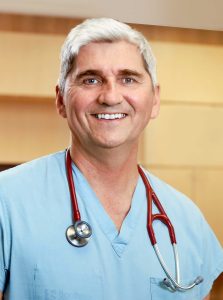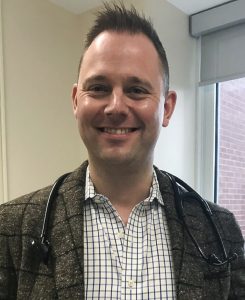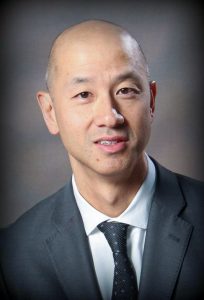Second in a four-part series called Code Now, a comprehensive look at how the Waterloo Region tech ecosystem can assist the local medical community during COVID-19 – and longer-term. In today’s segment, we hear doctors, a senior nurse, and administrators describe their most pressing back-office needs – solutions which will help squeeze more capacity out of the existing medical infrastructure and allow hospitals to target resources and people where they’re needed most. Editor’s note: Companies that believe they can provide a solution to any of the problems listed below should contact Communitech’s Medtech Startup Advisor, Armin Eichhorn, at armin.eichhorn@communitech.ca.

Peter Potts
Obstetrician and Chief of Staff at Grand River Hospital and St. Mary’s Hospital
PROBLEM: The world-wide shortage of masks and other personal protective equipment is, by this point, well known. Finding a way to re-use equipment that was designed to be disposable is top of mind with Potts. Grand River and St. Mary’s are experimenting with using a sterilization machine called a STERRAD to disinfect used N95 masks. The STERRAD machine uses low-temperature gas plasma and vapourized hydrogen peroxide to disinfect materials placed inside. Each machine is about the size of a filing cabinet; St. Mary’s has two of them and Grand River has one, and Grand River is considering ordering another.
The problem is logistical: Each mask user must bag their mask with a unique identifier, and a system is needed to ensure each mask is returned to its original wearer after sterilization.
“That’s top of mind for us,” Potts says. “The masks were initially intended to be disposable, but because of the worldwide shortage, we’re looking at really good stewardship of the masks, and then to reprocess them where possible.”
THE ASK: A system that can track each mask and ensure it gets returned to its owner.
° ° °
PROBLEM: From a logistics, stocking and ordering point of view, Potts says it’s crucial that the hospitals have better data and tracking capability.
“We really [need] to really understand how our masks are being utilized. So in other words, in real time, what we’d really like to know is: What our stores are, how fast our run rate is – how fast we’re depleting [masks and equipment] – and how we’re utilizing them and making sure we’re utilizing [equipment] in the best way we can.”
THE ASK: Software that can track mask and equipment usage and burn rate.
°°°
PROBLEM: Hospitals, like armies, need people on the front lines. But any army knows that getting soldiers into the trenches requires support behind the lines. A hospital is no different.
“Our [doctor] credentialing and recredentialing process is, right now, largely on paper,” says Potts. “There are some software programs already in existence [to help with that], but they’re not very good. We would love to be able to automate the physician onboarding, physician credentialing, and the physician continuing medical education process.
THE ASK: Software that can track doctor credentialing and medical education.
Bonnie Camm

Vice-President, Clinical Services, Grand River Hospital
PROBLEM: “We need [more complete] information with respect to patient flow through the system,” says Camm. “We’ve created a dashboard internally, but we don’t have a very transparent way of being able to see the execution and where we are – how a COVID-19 patient flows through the system, from the time they might engage at the assessment centre and are tested.” Often, Camm says, a patient will be instructed to return home after a test, and then be required to return to the hospital if they can’t manage. “So when they come back to the [Emergency Department], what’s that turnaround? How long has that been? How long do they stay in Emergency? Where do they go [next]? What’s the tracking of that patient in real time?”
Information of that kind, she says, would allow the staff to quickly see where bottlenecks are occurring and quickly direct more resources to clear them.
THE ASK: Dashboard-style software capable of tracking patient movement through the system.
°°°
PROBLEM: It’s one thing to know where and when a hospital bottleneck is occuring; it’s quite another to have enough human resources to respond to it. Camm would like a way for administrators to see in real time what staffing levels look like: The number of doctors and nurses and their specialities, the number of respiratory therapists, etc. Who is off work sick?
“Say we have a surge in the ICU, and we [suddenly] have 20 patients in ICU. Our staffing now has to shift and pivot because those patients are much more acute.
“So some transparency around staffing would really provide us with the ability to see it, and to be able to execute on that in a much more efficient way.”
THE ASK: Dashboard software that can track staff, a system possibly tied to the patient dashboard.

Dr. Stephen Giilck
General Internist and stroke specialist, Grand River Hospital
PROBLEM: “Despite a lot of discussion, I still don’t see that we have a solution with regards to supply-chain management, actually procuring the personal protective equipment,” says Giilck. “You know, globally, in Canada, and locally, I’ve heard good stories about local companies pivoting and starting to develop some of these things, which is fantastic. But there are other examples that [we’re not having as much success with] – access to drugs, for instance. And so a common one would be Ventolin. It’s prescribed for asthma. I’d say it’s one of the more common medicines that’s prescribed in an acute-care hospital or in the ward that I work in. Speaking to my colleagues in the community, this is in short supply and on back-order, and in my reading that is related to supply-chain issues.”
THE ASK: A solution to troubleshoot and resolve supply-chain issues to ensure timely delivery of needed medicine and equipment.
°°°
PROBLEM: For all the advances in world communication since the dawn of the internet age – email, chat groups, social channels – there’s no common forum for doctors around the world to talk with one another and quickly trade treatment solutions or findings.
“One of the overarching or bigger issues that we’re having is communication,” says Giilck, who explains that it has been difficult for doctors to get timely information from global virus hotspots about treatments and procedures that have shown success – and ones that haven’t.
“Europe was going through this, China was going through this, months before we did,” says Giilck. “I wouldn’t say we have a very clear, accurate description of how these patients are being managed.”
He would like to see a common forum, one that is searchable and can be categorized, to give doctors quick information on new techniques and treatments.
“And maybe some degree of peer review, where there’s a common editor or operator,” he says, “but not to the point that it has to be [formally] published, and that it takes, you know, a month to accomplish rather than days.
“A platform that would accomplish all that would benefit everybody.”
THE ASK: An online app or platform to enable doctors worldwide to quickly trade information and treatment methods related to COVID-19.

Robinne Hauck
Director Critical Care Surgery and Interim Chief Nursing Executive, Grand River Hospital
PROBLEM: Daily incoming shipments of vast amounts of material and personal protective equipment are siphoning off needed personnel in order to receive and catalogue goods. The process is time consuming.
“If there was a more automated process, it would certainly be a lot more efficient for us and a little bit more transparent for everybody,” says Hauck, who has 40 years of experience as a nurse.
THE ASK: A platform that would make inventory control and management of hospital supplies simpler and more efficient.
°°°
PROBLEM: Critical care, says Hauck, is labour intensive. Specialists are in demand the world over. A shortage of people with the right skills and talent who can care for the severely ill is causing staffing issues.
As a result, the hospital needs help with “the whole process of finding and hiring the proper people,” says Hauck.
THE ASK: Software, or an AI process, that can identify the right candidates, with the right credentials, and speed their onboarding.

Young Lee
Vice-President, Quality, Performance and Clinical Systems Transformation, Grand River Hospital
THE PROBLEM: Tracking people who have tested positive for the virus or are required to be isolated or in quarantine.
“Currently we rely on individual behaviour and compliance,” explains Lee.
THE ASK: A solution to bring greater visibility and to monitor behaviour – while at the same time respecting privacy.
Tomorrow, in Part III of Code Now:
Needs from the front lines: What doctors and nurses need now to help them cope with COVID-19 while simultaneously providing care for non-COVID-19-related cases.

